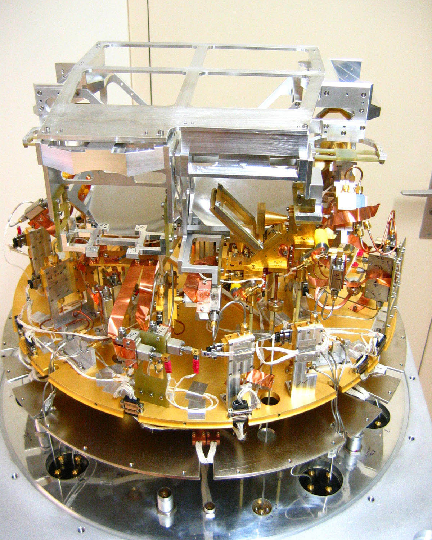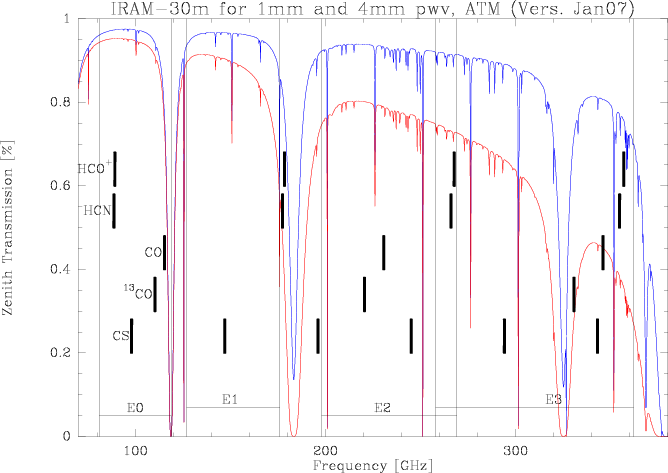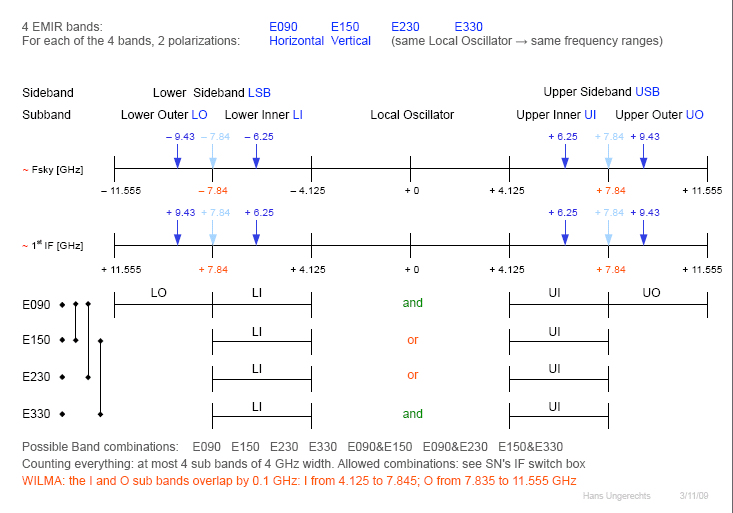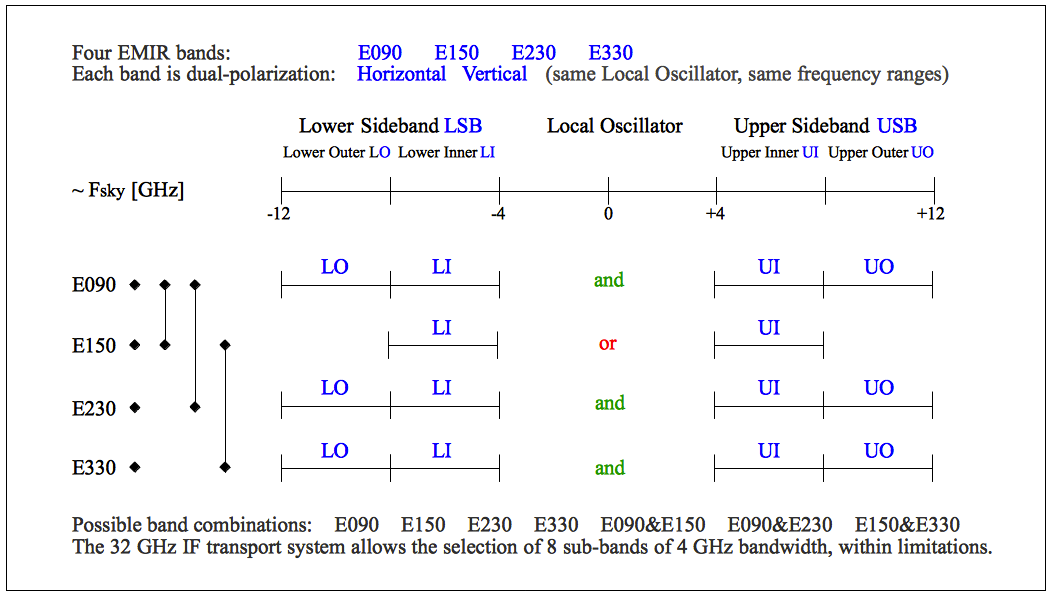|
Size: 24103
Comment:
|
Size: 24194
Comment:
|
| Deletions are marked like this. | Additions are marked like this. |
| Line 124: | Line 124: |
| More details on the selection rules and a sketch of the switch box, are given here: SwitchBoxDetails. See also the commissioning report below. | More details on the selection rules and a sketch of the switch box, are given here: SwitchBoxDetails. See also the [[http://www.iram.es/IRAMES/mainWiki/EmirforAstronomers#EMIRpaperandcommissioningReports|commissioning report]] below. |
Contents
-
EMIR Users Guide
- News
- Upgrades
- Sky frequencies
- Overview
- EMIR bands
- EMIR observable band combinations after the upgrade in November 2011
- Focal plane geometry
- Selection of EMIR bands (Dichroics)
- IF Distribution (Nov 2011)
- Connection to backends (July 2011)
- Calibration issues
- Correct frequency scales over upto 24 GHz of bandwidth
- PaKo user interface
- EMIR Observations Time Estimator
- Telescope efficiencies
- Status
- EMIR paper and commissioning Reports
- Friends of EMIR
EMIR Users Guide
News
- A dedicated paper on the working of EMIR and first results has been published -- see below.
- All EMIR band setups listed below have been commissioned successfully.
- The E0/E1 alignment is better than 1", after repositioning the EMIR caroussel no. 2 on 29-Nov, and later replacing its position sensor.
- The upper frequency limit of E3 is 352GHz, after installing a new local oscillator on 3-Jan-2012. With the previous LO and after the Nov-11 upgrade, we had only reached 334GHz.
Cold load temperatures may have changed slightly by 1-2K, but impact on calibration would be negligible (<1.5%).
Upgrades
Nov-2011: 2SB for E2 and E3
In the first week of November 2011, we upgraded EMIR with dual sideband (2SB) mixers for bands E230 and E330. These mixers cov er 8 GHz of instantaneous bandwidth per sideband and per polarization, like E090. E150 is unchanged with single sideband (SSB) mixers and 4 GHz bandwidth per polarization. Below, comment (4) on Table 1, gives the new frequency ranges of E2 and E3. Figures 4.1. and 4.2 show the new bands, the new switch box scheme, and examples of band combinations which can be observed simultaneously. Commissioning has finished. First regular observations with EMIR have started again on 15-Nov.
Jul-2011: 32GHz IF-system, FTS backends
Since July 2011, we have made available a new 32GHz IF system which includes 24 fast fourier transform spectrometers (FTS). This upgrade has duplicated the amount of instantaneous bandwidth available at the 30m telescope. 16 GHz of bandwidth can now be used instantaneously, in both polarisations. Eight cables of 4GHz width now carry the intermediate frequencies through the telescope cable spiral to the backend room. The full 32GHz of bandwidth are covered by 24 FTS working at 200kHz resolution. This improves the available velocity resolution over large bandwidths by a factor of 10 compared to WILMA with its 2MHz resolution. It is now possible to observe at 0.6km/s resolution in the 3mm band allowing to resolve star forming clouds in the Milky Way and in nearby galaxies. The resolution of the 24 FTS can further be increased to 50 kHz, in which case only the inner 1.82GHz of the 4GHz EMIR bands are covered. The previous 4x4GHz system is still in use, and the additional 4x4GHz cables are connected to the outer 4GHz wide bands of EMIR 3mm channel, i.e. to E0UO and E0LO in both polarisations. All FTS units work either at 200 kHz or at 50 kHz. However it is not possible to set them individually to different resolutions. The new FTS can also be connected to the 2x9 HERA cables of 1GHz width, both at 200kHz or at 50kHz resolution. See also the call for proposals for the deadline in September 2011.
See a brief report further below, and an overview of available backends, including the new broad band continuum (bbc) backend and the new IF distribution.
Sky frequencies
Before the upgrade of E2 and E3 in November 2011
EMIR |
Fsky |
mixer |
polar- |
IF width |
Trx |
Gim |
|
combinations |
Trx |
Remark |
|||
band |
GHz |
type |
isation |
GHz |
K |
dB |
|
E0/2 |
E1/3 |
E0/1 |
K |
|
|
E0 |
83-117 |
2SB |
H/V |
8 |
50 |
>10 |
|
X |
|
X |
65 |
|
(1) |
E1 |
129-174 |
SSB |
H/V |
4 |
50 |
>10 |
|
|
X |
X |
65 |
|
(2) |
E2 |
201-267 |
SSB |
H/V |
4 |
50 |
>10 |
|
X |
|
|
65 |
|
(4) |
E3 |
260-348 |
2SB |
H/V |
4 |
70 |
>10 |
|
|
X |
|
85 |
|
(3, 4) |
After the upgrade of E2 and E3 in November 2011
EMIR |
Fsky |
mixer |
polar- |
IF width |
Trx |
Gim |
|
combinations |
Trx |
Remark |
|||
band |
GHz |
type |
isation |
GHz |
K |
dB |
|
E0/2 |
E1/3 |
E0/1 |
K |
|
|
E0 |
83-117 |
2SB |
H/V |
8 |
50 |
>10 |
|
X |
|
X |
65 |
|
(1) |
E1 |
129-174 |
SSB |
H/V |
4 |
50 |
>10 |
|
|
X |
X |
65 |
|
(2) |
E2 |
202-274 |
2SB |
H/V |
8 |
50 |
>10 |
|
X |
|
|
65 |
|
(4) |
E3 |
277-352 |
2SB |
H/V |
8 |
70 |
>10 |
|
|
X |
|
85 |
|
(3, 4) |
Table 1: EMIR Frontend. Sky frequencies Fsky are given for the centers of the outermost 4GHz IF bands (cf. Fig.3 and 4). Acronyms: 2SB - dual sideband mixers, SSB - single side band mixers, H/V -- horizontal and vertical polarizations, Trx is the SSB receiver temperature in single sideband observations, Gim is the image band rejection. Note that the receiver noise is somewhat increased when observing with two bands simultaneously due to the dichroic elements needed for these observations (see below for more details).
(1) At frequencies below 83GHz, the receiver gain ratio is known to vary strongly over the bandpass and between the two polarisations. In addition, the receiver noise temperatures increase.
(2) Sky frequencies between 174 and 189 GHz have been successfully tested (Sep-09, 19-Sep-11) and may be available on special request. At the highest frequencies the receiver temperatures increase to about 130K and the sideband gain-ratio is not well known.
(3) As described in the commissioning report, the local oscillator of E3 shows instabilities at a few frequencies. If you as observer encounter such problems, please contact the operator and/or receiver engineer. Swapping the sideband may help.
(4) In November 2011, EMIR bands E2 and E3 have been upgraded to full dual-polarisation, dual-sideband 8GHz each mixers. The frequency ranges have changed, in particular the overlap region between E2 and E3. Above, we give the new frequency ranges of E2 and E3. These are the centers of the outer bands which are reachable by all backends including VESPA. The FTS at 200kHz can reach frequencies which lie 2GHz further out.
Overview
The new receiver EMIR (Fig.1) has been installed and commissioned at the 30m telescope in March through April 2009. EMIR replaced the single pixel heterodyne receivers A/B100, C/D150, A/B230, and C/D270. HERA, the bolometers, and the backends are unchanged. EMIR provides a minimum instantaneous bandwidth of 4 GHz in each of the two orthogonal linear polarizations for the 3, 2, 1.3 and 0.9mm atmospheric windows (Fig.2). In addition to the vast increase in bandwidth, the receiver is offers considerably improved noise performance, a stable alignment between bands, and other practical advantages.
The four EMIR bands are designated as E090, E150, E230, and E330 according to their approximate center frequencies in GHz. While the E150 band has SSB mixers with a single sideband available at a time, the E090, E230, and E330 bands can be operated in 2SB mode where both sidebands are available for connection to backends. Furthermore, these bands are built in a technology that offers 8 GHz instantaneous bandwidth per sideband and polarization -- after the upgrade in Nov-2011. Both polarizations of a given band will always be tuned to the same frequency as they share a single common local oscillator. The tuning ranges of the 4 bands, the typical receiver noise temperatures, and other parameters are listed in Tab.1.
EMIR provides for the first time in the history of the 30m telescope a permanently available high sensitivity E330 band, opening this atmospheric window for regular use under good weather conditions. See the commissioning report below.

Figure 1: EMIR during final integration in the Grenoble receiver laboratory. One of the four dual-polarization mixer pairs is visible near the center of the photograph. The beams of the 4 mixer pairs leave the dewar through 4 separate windows towards the top of the figure. Warm optics (not shown) can combine some of the 4 beams for observation of the same position on the sky.

Figure 2: Atmospheric transmission between 60 and 400GHz for two precipitable water vapors, modeled with the ATM model. The EMIR bands are marked together with the frequencies of a few important molecular transitions.
EMIR bands

Figure 3: Visual overview of EMIR bands currently available, i.e. before the upgrade in November 2011.

Figure 4.1: Overview of EMIR bands after the upgrade of E2 and E3 in November 2011. The frequencies given at the edges of the bands should be considered as indications only since they will likely slightly change in the future.
EMIR observable band combinations after the upgrade in November 2011
EMIR has four different bands covering the four main atmospheric windows in the millimetre range: E090, E150, E230 and E330. Dual band observation is possible but only the E0/E1, E0/E2 and E1/E3 band combinations are allowed by the receiver optics. After the upgrade in November 2011, bands E0, E2 and E3 have four IF outputs each: 2 polarizations (H,V) and 2 sidebands (L,U), each of them is 8 GHz wide. Band E1 has only two IF outputs, 4 GHz wide each, of different polarizations but same sideband. The 8GHz wide IF outputs are split in two blocks, 4 GHz wide each, denoted by I and O (inner and outer) and sent to the spectrometers by the use of in total 8 coaxial cables. This means that a total of 32GHz of bandwidth are transferred to the spectrometers. A future upgrade to 64GHz allowing simultaneous observations of E0 and E2 with all bands, is planned.
When designing the new switch box, we assumed that most, if not all observers use both polarisations simultaneously.
Commissioned EMIR band combinations or setups, after the Nov 2011 upgrade:
One band only:
- E0 LI+LO, UI+UO (16GHz of instantaneous bandwidth with both polarisations at 3mm)
- E2 LI+LO, UI+UO (16GHz of instantaneous bandwidth with both polarisations at 2mm)
- E3 LI+LO, UI+UO (16GHz of instantaneous bandwidth with both polarisations at 1mm)
- E2 LO+UO (special setup to use only IF bands 1-4, allowing to connect VESPA e.g. for polarimetry)
- E0/E2:
E0: UI+UO, E2: UI+UO (e.g. 12CO, 13CO 1-0, 12CO 2-1, dual-pol)
E0: LI+LO, E2: LI+LO (e.g. HCN, HCO+ 1-0, 13CO 2-1, dual-pol)
E0VUO (12CO 1-0), E2VUI, E2HUI (12CO 2-1), E2HLI (13CO & C18O 2-1) [only 4 IF-cables used]
E2HLI, E2HUI, E0VUI (or any other E0V band) (12CO & 13CO 2-1 + 3mm) [single-pol]
- E2UO, E2UI, E0UO, E0UI (using IF-cables 1-4, available since 12-Jan-2012)
- E1/E3:
- E1V+E1H+E3VL+E3HL ! This is the only possible setup for E1/E3. Inner and outer bands can be observed simultaneously for E3. Only the lower sideband is available for E3:
E1LI, E3LI, E3LO (dual-pol)
E1UI, E3LI, E3VLO (dual-pol)
- E1V+E1H+E3VL+E3HL ! This is the only possible setup for E1/E3. Inner and outer bands can be observed simultaneously for E3. Only the lower sideband is available for E3:
- E0/E1:
- Together with E1, only the lower bands of E0 can be observed in dual-pol. Inner and outer bands can be observed simultaneously for E0. Only the lower sideband is available for E0. Important application: CS 2-1, 3-2.
EOLI, E0LO, E1LI (dual-pol)
E0LI, E0LO, E1UI (dual-pol)
- E0LOH, E0LIV, E0UIH, E1LIV ! special setup, as only one polarisation of E1LI is used, one winter proposal
- Together with E1, only the lower bands of E0 can be observed in dual-pol. Inner and outer bands can be observed simultaneously for E0. Only the lower sideband is available for E0. Important application: CS 2-1, 3-2.
Setups which are not possible (even after the EMIR upgrade in Nov-2011):
3mm: UI+UO, 1mm: LI+UI (12CO, 13CO 1-0 & 2-1) ! Only a maximum of 4 inner cables can be selected.
- E0 LI,UI + E2 LI,UI ! Only a maximum of 4 inner bands can be selected. In general, when connecting to E2 LI+UI with both polarisations, none of the inputs of E0 are accessible.
- E0 LO UO + E2 LO LI
- 50kHz FTS: C18O, 13CO, 12CO 1-0 simultaneously. These lines lie 5.49GHz apart, while the outer edges of the FTS 50kHz units in the inner and outer band of EMIR lie 5.42GHz apart. The inner edges lie 1.78GHz apart. However, it is no problem to observe these lines simultaneously with 200kHz resolution.
- E0 alone with only two If cables attached, e.g. horizontal LI vertical LI, results in corrupted FTS raw data (imbfits files that mira can not read and result in a Segmentation fault). A Workaround is to attach 4 cables, e.g. horizontal UI+LI and vertical UI+LI.
More details on the selection rules and a sketch of the switch box, are given here: SwitchBoxDetails. See also the commissioning report below.
Focal plane geometry
The four bands will be combined in only two possible beams (left and the right beams when looking to the cryostat front face). The left and right beams are offset by about 90" on the sky. See the telescope status page for the present Nasmyth offsets (cf. EMIR Commissioning report below). Observations are carried out with either of the two beams. Simultaneous observations with both beams are at present not supported.
Selection of EMIR bands (Dichroics)
 Before reaching the Nasmyth mirrors, the four beams of the EMIR bands pass through warm optics that contains switchable mirrors and dichroic elements for redirection of the beams towards calibration loads and for combining beams. In its simplest mode, the warm optics unit selects one single EMIR band for observation. This mode avoids the use of the slightly lossy dichroic elements and therefore offers the best receiver noise temperatures.
Before reaching the Nasmyth mirrors, the four beams of the EMIR bands pass through warm optics that contains switchable mirrors and dichroic elements for redirection of the beams towards calibration loads and for combining beams. In its simplest mode, the warm optics unit selects one single EMIR band for observation. This mode avoids the use of the slightly lossy dichroic elements and therefore offers the best receiver noise temperatures.
Three dichroic mirrors are available for combining either the E090 and E150 beams, or the E090 and E230 beams, or the E150 and E330 beams (Table 1). The combination of bands is not polarization selective, i.e. the combined bands will stay dual polarization. The loss of these dichroics increases however the receiver temperatures by, in general, only 10 - 15 K. The losses of E2 (due to the use of the dichroic) are higher than 10% for frequencies above ~258GHz and below ~202GHz (cf. Table 2). The polarization angle of the dichroic was chosen to minimize the losses for 231GHz. The observer is therefore adviced to carefully evaluate whether an observation involving two different bands is more efficiently made in parallel or in series.
Note that simultaneous observations of e.g. HCO+ at 89.7 and 266.5GHz with E0 and E2, will suffer from much increased system temperatures in E2, due to the losses of the dichroics using this frequency combination.
The dichroics are needed for dual-band observations with EMIR. The following table shows the losses of the dichroics, based on a separate mixer and dichroic characterization done in the receiver lab by Anne-Laure Fontana in Feb 09. This table is subject to change with new measurements of the integrated receiver, and with new dichroics.
Table 2: Performance of dichroics (February 2009, Report of Anne Laure):
E0/E2 |
E0/E1 |
E1/E3 |
|||||||||
E0 |
E0 |
E2 |
E2 |
E0 |
E0 |
E1 |
E1 |
E1 |
E1 |
E3 |
E3 |
GHz |
% |
GHz |
% |
GHz |
% |
GHz |
% |
GHz |
% |
GHz |
% |
84-108 |
2.5 |
202 |
10 |
84 |
4 |
129 |
5 |
129-138 |
2.5 |
261-357 |
<2.5 |
116 |
<2 |
213 |
5 |
92 |
3.2 |
138-156 |
1 |
147 |
4.5 |
369 |
7 |
|
|
225 |
3 |
100-110 |
5 |
168 |
2 |
156 |
3.5 |
|
|
|
|
231 |
2 |
110-115 |
~10 |
171 |
2 |
174 |
2.5 |
|
|
|
|
243 |
5 |
|
|
174 |
2 |
|
|
|
|
|
|
255 |
5 |
|
|
|
|
|
|
|
|
|
|
258 |
10 |
|
|
|
|
|
|
|
|
|
|
267 |
50(!) |
|
|
|
|
|
|
|
|
Each percent of losses, increases the receiver temperature by about 4K.
IF Distribution (Nov 2011)
An overview of the frequency distribution of the entire system is given here.
Connection to backends (July 2011)
Four output channels are sent via the IF cables to a backend distribution unit which provides copies of these 4 channels to a range of backends processors which then prepare the IF signals for distribution to the spectrometers. Three backend processors have been build to feed the new 4 GHz wide IF channels to the existing backends:
The WILMA processor rearranges the four incoming 4 GHz wide IF channels into 16 channels of 1 GHz width which can be processed by 16 WILMA autocorrelator units. Since each unit provides 512 spectral channels of 2 MHz, sufficient backend power is available at low spectral resolution for full coverage of the 4x4GHz bottleneck.
The 4 MHz processor rearranges any two incoming 4 GHz wide IF channels into 8 slices of 1 GHz width for processing in 8 units of the 4 MHz filter bank. 2x4 GHz of EMIR bandwidth are thus covered at 4 MHz resolution.
The narrow backend processor prepares the 4 incoming IF channels for input into VESPA. Only the central part of the 4 GHz IF channels is accessible to these backends. Inside this central part (1 GHz for the filterbank and 640 MHz for VESPA), these backends can be configured as before. The VLBI terminal is also fed from this processor.
The 24 fast fourier transform spectrometers (FTS) are handled separately.
Backends at the IRAM 30m telescope
Calibration issues
EMIR comes with a new calibration system. The external warm optics provides ambient temperature loads and mirrors reflecting the beams back into the 15 K stage of the cryostat. This system is expected to be very reliable and constant over time. Absolute calibration accuracy will be better than 10% with EMIR when all details are well settled.
Band E150 has backshort tuned single-sideband mixers; DSB tuning is not possible, but sidebands (USB or LSB) may be selectable within limitations. The image rejection is better than 10 dB for all frequencies. On-site measurements of the rejection is not longer straightforward for these mixers, since the Martin--Puplett interferometers are not available anymore. As the optimum way of calibrating the image rejection is still under exploration, users who propose observations which rely on an enhanced accuracy of calibration of image gains should mention this request in the proposal.
The other bands have tunerless sideband separation mixers, allowing simultaneous observations of both sidebands in separate IF bands. These mixers have been characterized in the laboratory for their image rejection and are expected to have the same performance on site (>13dB).
Correct frequency scales over upto 24 GHz of bandwidth
It is common practice at radio observatories to correct the frequency of an observation for the strongly time variable velocity of the Observatory with respect to the solar system barycenter. This guarantees that lines observed near the Doppler-tracked frequency, usually the band center, always have the correct barycentric velocity, independent of the time of observation. However, the effect of the Observatory's motion on the velocity scale at frequencies which are far from the Doppler-tracked frequency, is usually ignored.
This effect which is of the order of 1e-4 cannot be neglected anymore if large bandwidths are used, as with EMIR. The worst case occurs when channels as far away as 20 GHz need to be considered if a velocity channel in one of the sidebands is Doppler-tracked. In unfavorable but nevertheless frequent cases (target source not too far from the ecliptic, like the Galactic center), shifts of up to +/-2 MHz occur. In principle, CLASS corrects the shifts. However, as the report below describes, these shifts correspond to time variable changes of the frequency resolution. Co-adding or averaging spectra taken at different times, may then lead to a broadening of the effective frequency resolution.
Accurate line center frequencies: Report of 03-Aug-2011 by Buchbender, Kramer et al.. Two bugs in mira and class caused frequency shifts and have been corrected for. The new versions of mira and class were installed at the 30m on 16-Aug-2011.
PaKo user interface
The new default PaKo version supports the upgraded E2 and E3 mixers and the enhanced IF switch box. See the current PaKo manual
Please contact your astronomer-of-duty to help you prepare scripts or in case of any questions.
EMIR Observations Time Estimator
Telescope efficiencies
Status
EMIR paper and commissioning Reports
The EMIR Multi-band mm-Wave Receiver for the IRAM 30m Telescope, Carter, Lazareff et al. 2012 (A&A, in press)
- Commissioning Reports:
Bands 1-3: EmirCommissioningReportVers1.1.pdf (4/2009)
Band 4: emir-e3-com-report-05apr2010.pdf (4/2010)
Polarimetry (Bands 1&3) wiesemeyer-thum-xpol-report-10aug2010.pdf (8/2010)
Upgrade to 32GHz IF system kramer-aug2011-32ghz-newsletter.pdf (7/2011)
- Upgrade of E2 and E3 mixers (Nov 2011)
emir-nov11-com-report-v1.0.pdf Report on spectral line test observations by Kramer et al.
Friends of EMIR
During the first half of the 2009 summer semester, each EMIR project had an IRAM astronomer assigned to it, to help with setting up the scripts and observations. See here: Friends of EMIR Projects. This extra service is not continued. Instead, we now provide template scripts and an updated PaKo manual.
This page is maintained by C.Kramer. Any comments are welcome.

